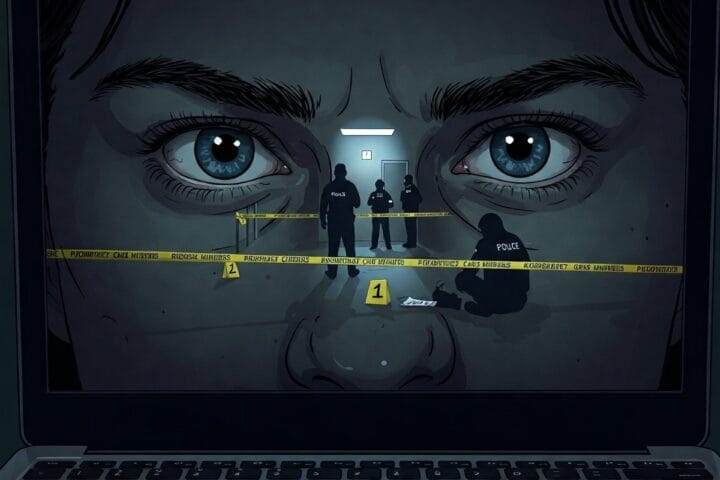Have you ever wondered how detectives are able to solve seemingly unsolvable murder mysteries? You’ve probably watched plenty of TV shows where forensic scientists uncover tiny clues and catch the bad guys with some high-tech gadget. While some of that is exaggerated for entertainment, forensic science has been instrumental in cracking many famous real-life cases. From fingerprint and DNA analysis to reconstructing crime scenes, forensic techniques have helped identify numerous evil perpetrators who thought they got away with murder. In this article, we’ll explore how forensic science was pivotal in solving several notorious true crime cases that stumped investigators and brought dangerous criminals to justice. Read on for the chilling details of how science and detective work combined to catch killers.
What Is True Crime?
True crime is a genre focused on real criminal cases and events. Unlike mysteries or thrillers, true crime deals with actual crimes, usually murders or other acts of violence. These real-life cases have long fascinated readers and viewers.
Some well-known examples of true crime stories include:
- The infamous murders committed by Jack the Ripper in 1888. The unsolved case of the serial killer who butchered several women in London’s Whitechapel district still intrigues people today.
- The shocking 1932 kidnapping and murder of Charles Lindbergh Jr., the 20-month-old son of famous aviator Charles Lindbergh. The “Trial of the Century” led to the execution of Bruno Hauptmann, who was convicted of the horrific crime.
- The notorious murders of Nicole Brown Simpson and Ron Goldman in 1994. The highly publicized trial of O.J. Simpson, the prime suspect in the killings and Brown Simpson’s ex-husband, captured the world’s attention.
- The unsolved 1996 murder of child beauty queen JonBenét Ramsey. The mysterious death of the 6-year-old in her Colorado home has spawned many theories about who killed her.
True crime stories have been popular for centuries and continue to fascinate us today. Whether in books, movies, TV shows, or podcasts, people can’t seem to get enough of these dramatic and unsettling tales of mystery, murder, and the human psyche. The genre shows no signs of slowing down anytime soon.
Famous True Crime Cases That Shocked the Nation
Some of the most well-known true crime cases were solved thanks to forensic science. These shocking cases gripped the nation as the gory details and twists were revealed.
The Lindbergh Kidnapping
In 1932, famous aviator Charles Lindbergh’s baby boy was kidnapped and later found dead. The kidnappers had left a ransom note, which gave investigators hope that the baby was still alive. After tracing the wood used to make the ladder left at the crime scene and using handwriting analysis on the ransom note, investigators charged Bruno Hauptmann with the kidnapping. He was later convicted and executed.
The Zodiac Killer
From the late 1960s to early 1970s, the Zodiac Killer terrorized San Francisco. He murdered at least five people and taunted police with cryptic notes and ciphers. Though the killer was never caught, saliva on stamps may have provided a DNA profile. Handwriting analysis also suggested the killer had a disturbed, egocentric personality. Some theorize the Zodiac murders have gone unsolved due to lack of forensic technology at the time.
The Unabomber Case
Ted Kaczynski, known as the Unabomber, targeted people associated with modern technology between 1978 to 1995. His bombs killed three people and injured 23. The FBI published his manifesto, hoping someone would recognize his writing style. His brother came forward, recognizing phrases that matched letters he had received. Investigators found evidence in Kaczynski’s cabin, including bomb materials that matched devices used in the attacks. Kaczynski pleaded guilty and is now serving life without parole.
Forensic science has been instrumental in solving some of the most infamous crimes. Though grisly, these cases demonstrate how far we’ve come in using evidence to find the truth.
How Forensic Science Helped Crack the Zodiac Killer Case
The Zodiac Killer case is one of the most infamous unsolved serial murder cases in American history. For years, the Zodiac taunted police and media with cryptic letters and ciphers. However, thanks to forensic science, investigators were able to glean critical clues from the killer’s messages and crime scenes.
In 1969, the Zodiac Killer attacked two college students in a secluded area of Vallejo, California. Police discovered a bloody crime scene, but the female victim survived and gave a description of her assailant. The male victim, however, succumbed to his wounds. During the attack, the killer lost a piece of a rare, expensive watch. An expert analyzed the watch fragment and traced it to only a few hundred possible watches—a major lead.
The killer began sending coded letters to police and newspapers, signing them with a crossed-circle symbol. In one, he claimed responsibility for the murders, threatened to kill again, and challenged police to crack his cipher. Codebreakers worked for days and finally deciphered the message, but it yielded little useful information. Still, the handwriting and linguistic style provided more clues to the killer’s possible background.
After more attacks, the Zodiac sent another letter containing a bloody piece of shirt. DNA testing, though primitive at the time, indicated the blood type matched that of a victim, verifying the letter’s authenticity. In 2002, the shirt was retested using advanced DNA technology, yielding a partial DNA profile of the Zodiac Killer. However, there were no matches in criminal databases.
Though the case remains unsolved, without forensic science, little would be known about the Zodiac Killer. Codebreaking, handwriting analysis, fingerprinting, DNA—each technique provided a new piece of the puzzle. Tantalizing clues like the watch fragment, bloody swatches of shirt, and DNA profile continue to give hope that one day this cold case may be cracked wide open. The killer may have outwitted police during his reign of terror, but thanks to the tireless work of forensic scientists, his identity may still be within our grasp.
DNA Analysis and the Capture of the Golden State Killer
DNA analysis has revolutionized criminal investigations. Nowhere is this more evident than in the case of the Golden State Killer, a serial predator who terrorized California in the 1970s and ‘80s. For decades, his identity remained a mystery. That is, until science caught up with him.
In 2018, authorities arrested 72-year-old Joseph James DeAngelo for the Golden State Killer crimes. They were able to identify DeAngelo through a new technique that combines DNA from crime scenes with genealogy websites. Investigators uploaded a DNA sample from one of the crime scenes to GEDmatch, a public genealogy database. They found a familial match that led them to identify DeAngelo as a suspect.
Once they had DeAngelo in their sights, investigators tracked his movements and collected DNA samples from places he frequented, like a restaurant. They matched those samples to evidence from the Golden State Killer’s crimes, confirming they had found their man. DeAngelo’s arrest shows how a few cells of DNA and a clever genealogical technique can unravel even the coldest of cases.
DeAngelo pleaded guilty to 13 murders and 13 rape-related charges in 2020, admitting he was the sadistic Golden State Killer who stalked victims and attacked them in the sanctity of their own homes. His crimes spanned at least a decade across parts of California, making him one of the most prolific unidentified criminals in U.S. history until science finally caught up with him.
The Golden State Killer case highlights how far forensic science has come. Not that long ago, without DNA or genealogy websites, monsters like DeAngelo could remain faceless and escape justice. Thanks to modern methods, even killers who lurk in the shadows for decades may still find their evil deeds coming into the light. The era of the unidentified criminal mastermind seems to be coming to an end. No one, no matter how depraved, can outrun science and technology forever.
Blood Spatter Analysis in the OJ Simpson Trial
The 1995 O.J. Simpson murder trial was a media circus that captivated the nation. A crucial piece of evidence for the prosecution was the blood spatter found at the crime scene. Blood spatter analysis, a forensic technique using the size, shape, and pattern of blood drops to reconstruct events, seemed to tell a damning story.
Bloody Footprints
Detectives found bloody footprints at the crime scene that matched O.J.’s shoe size. The prosecution argued that the footprints were left by O.J. as he walked through pools of blood after killing Nicole Brown Simpson and Ron Goldman. However, O.J.’s defense team claimed that the footprints could have been left by police personnel trampling through the crime scene, contaminating evidence.
The Trail of Blood
A trail of blood drops led away from the bodies, along the walkway of Nicole’s condo, and into O.J.’s car. The prosecution said this showed that O.J. walked to his car after the murders with blood on his shoes and hands. But the defense argued that the blood had been planted or contaminated by police.
Blood on the Glove
A bloody glove was found at the scene, and its mate was found near O.J.’s house. DNA testing showed the blood on the gloves matched Nicole, Ron, and O.J. However, when O.J. tried on the gloves in court, they didn’t seem to fit, raising doubts. The prosecution claimed the gloves must have shrunk from being soaked in blood, while the defense said this proved the evidence was compromised.
The bloody footprints, trail of blood, and bloody glove seemed to prove O.J.’s guilt. However, issues like possible evidence contamination, police misconduct, and the ill-fitting glove gave the jury reasonable doubt. After just four hours of deliberation, O.J. was acquitted of all charges, though he was later found liable for the deaths in a civil trial. The O.J. Simpson trial showed that while forensic science can provide powerful evidence, it must be handled properly to stand up in court.
Fingerprinting and the BTK Killer
Fingerprinting has been crucial in identifying and capturing some of the most notorious criminals. One of the most well-known cases where fingerprint evidence was pivotal was that of the BTK Killer, Dennis Rader.
The BTK Killer Terrorizes Wichita
Between 1974 and 1991, the BTK Killer (which stood for “Bind, Torture, Kill”) murdered 10 people in the Wichita, Kansas area. He would break into homes, bind and strangle his victims, then indulge in disturbing rituals with the bodies. The killer sent taunting letters to police and media, but always managed to evade capture.
In 2004, Rader resumed sending letters, which ultimately led to his arrest. Police were able to lift several partial fingerprints from the letters and match them to prints on file for Rader, who was working as a compliance officer. Upon questioning, Rader confessed to the BTK murders.
Fingerprints had been collected from Rader during a routine background check for his job in 1989. At the time, fingerprint matching was done manually and took hours. By 2004, automated fingerprint identification systems allowed investigators to quickly search through thousands of prints to find a match.
Rader’s past was unassuming – he lived a seemingly normal life with a wife and two children. This case highlighted how dangerous it can be to make assumptions based on appearances.
Fingerprint evidence was instrumental in identifying and stopping this vicious killer who evaded justice for over 30 years. Advancements in technology and forensics meant his days of terrorizing Wichita were finally over. The BTK case showed the power of science and perseverance in solving even the coldest of cases. Fingerprinting, in particular, has become an invaluable tool for identifying perpetrators and bringing them to justice.
Toxicology Testing in the Murder of JonBenet Ramsey
Toxicology testing was crucial in solving the murder of 6-year-old JonBenet Ramsey. On December 26, 1996, JonBenet was found dead in the basement of her family’s home in Boulder, Colorado. The cause of death was asphyxiation due to strangulation, along with a skull fracture. Handwriting experts analyzed the unusual ransom note left at the scene, but DNA and fingerprints yielded no matches.
Investigators turned to forensic toxicology to uncover clues. JonBenet’s body showed no signs of a struggle, suggesting she was incapacitated when the attack occurred. Toxicology reports found no alcohol, common date rape drugs or narcotics in her system. However, medical examiners did detect the presence of a metabolite of an over-the-counter substance called bromethalin, used in rat poison.
Bromethalin is an neurotoxin that causes swelling in the brain, headaches, nausea, and respiratory failure. At high enough doses, it can lead to coma and death. The amount found in JonBenet’s system was a potentially lethal dose for a child of her size.
The discovery of bromethalin was a breakthrough. Someone had given or administered the toxin to JonBenet in order to sedate her. The kidnapper likely did not intend to kill her initially, but her death was the tragic result of an overdose of this poison.
With this toxicology evidence, investigators could deduce a possible sequence of events. The kidnapper fed JonBenet bromethalin to knock her out, then began crafting the ransom note and staging the crime scene. By the time the kidnapper realized JonBenet had stopped breathing, it was too late. In a panic, the kidnapper then strangled and assaulted JonBenet to make it appear as though she was killed during a botched kidnapping.
To this day, JonBenet’s murder remains unsolved. Yet toxicology testing was pivotal in revealing a key piece of the puzzle and pointing investigators to the probable use of a sedative by her killer. Forensic science gave a voice to a victim who could no longer speak, helping to expose the sinister truth behind an evil deed.
Digital Forensics and the Conviction of Paul Bernardo
Digital forensics played an instrumental role in securing the conviction of Canadian serial killer Paul Bernardo. Nicknamed the “Scarborough Rapist,” Bernardo terrorized southern Ontario in the late 1980s and early 1990s, committing over a dozen brutal rapes and murders along with his wife Karla Homolka.
Investigators had collected DNA evidence from the crime scenes that pointed to the same unknown male perpetrator. However, a DNA sample from Bernardo was not obtained until 1993, when he was investigated for the kidnapping and murder of two teenage girls. Forensic testing confirmed that Bernardo’s DNA matched the samples from the Scarborough rapes.
Bernardo’s home computer also provided crucial evidence. Digital forensic examiners were able to recover deleted files showing that Bernardo had been researching his victims before the attacks. They found downloaded maps of the neighborhoods where victims lived and worked. His Internet history revealed that Bernardo frequented message boards and chat rooms to discuss violent sexual fantasies, especially those involving teenage girls.
Most damning were digital photos of Bernardo posing with an unconscious young woman. At first, Homolka claimed the pictures depicted a consensual sex act. However, digital timestamp analysis proved the photos were taken during the time period when Leslie Mahaffy, one of the murder victims, was being held captive in their home. This revelation led Homolka to accept a plea deal in exchange for testifying against Bernardo.
Thanks to advancements in forensic science, investigators were able to conclusively link Bernardo to the Scarborough rapes through DNA. Digital forensics further connected him to the kidnappings and murders, proving he had stalked and planned to victimize his targets. The electronic evidence, combined with Homolka’s testimony, ensured that Bernardo would be found guilty on multiple charges of murder, kidnapping, and aggravated sexual assault. He received a life sentence and will remain behind bars indefinitely.
True Crime FAQs: Your Most Pressing Questions Answered
True crime is a popular genre, but it can also bring up a lot of questions. Here are some of the most frequently asked questions about true crime, answered.
What exactly is “true crime”?
True crime refers to non-fiction accounts of real criminal cases. It includes books, podcasts, TV shows, and documentaries. True crime aims to explore real murders, unsolved cases, and other unlawful acts. Popular examples include Serial, Making a Murderer, and My Favorite Murder.
Are true crime creators profiting from tragedy?
This is a complex issue with valid arguments on both sides. While some see true crime as exploiting victims and their families for entertainment, others view it as raising awareness of important social issues, like wrongful convictions or police misconduct. As with any genre, it depends on how responsibly and ethically the material is handled. Many creators aim to tell stories with sensitivity by focusing on the humanity of everyone involved.
Do true crime stories glorify violence?
This is another nuanced debate. Some studies have found a link between consuming violent media and increased aggression, but the evidence is mixed. True crime that lingers on gory details or treats violence lightly could potentially normalize harm. However, most experts agree that when done responsibly, true crime need not glorify violence. The genre can bring awareness to issues like domestic abuse or the shortcomings of the legal system. Focusing on the humanity of all people involved, treating victims with dignity, and condemning acts of violence help prevent glorification.
Why are people so fascinated by true crime?
There are a few reasons for the appeal of true crime:
•Morbid curiosity. Learning about gruesome acts stirs our morbid curiosity, even if unpleasant.
•Puzzle-solving. Trying to solve mysteries along with investigators is compelling. We want to figure out whodunnit.
•Vicarious thrill. Experiencing fear and suspense secondhand gives us an adrenaline rush without real danger.
•Insight into human nature. True crime provides a glimpse into both the good and evil that humans are capable of. We can gain insight into psychology and what drives certain actions.
•Seeking justice. Following a case until its resolution, whether through conviction or vindication, satisfies our innate desire for justice and fairness. We want to see the truth come out.
•Appreciation of own safety. Learning about threats to human life, even when disturbing, fosters gratitude for the safety and security in our own lives. We feel relief that the tragedy didn’t happen to us or our loved ones.
So there you have it—some of the most notorious killers and criminals brought to justice thanks to the meticulous work of forensic scientists and investigators. While these evil deeds will continue to shock and captivate us, at least we can take solace knowing that science and justice prevailed. The next time you delve into a true crime story, whether in book, podcast or Netflix form, appreciate the painstaking work that went into solving the case. And remember that as much as we’re fascinated by the sinister minds of these perpetrators, good will always triumph over evil so long as we have dedicated scientists working behind the scenes to uncover the truth. Sweet dreams!












